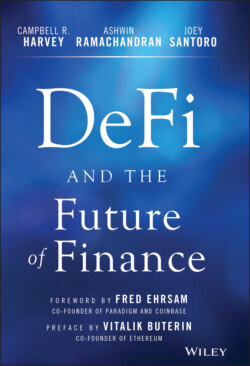Читать книгу DeFi and the Future of Finance - Campbell R. Harvey - Страница 10
BITCOIN AND CRYPTOCURRENCY
ОглавлениеThe dozens of digital currency initiatives beginning in the early 1980s all failed.5 The landscape shifted, however, with the publication of the famous Satoshi Nakamoto Bitcoin white paper6 in 2008, which presents a peer-to-peer system that is decentralized and uses the concept of blockchain. Invented in 1991 by Haber and Stornetta,7 blockchain was initially primarily envisioned to be a time-stamping system to keep track of different versions of a document. The key innovation of Bitcoin was to combine the idea of blockchain (time stamping) with a consensus mechanism called proof of work (introduced by Back8 in 2002). The technology produced an immutable ledger that eliminated a key problem with any digital asset: you can make perfect copies and spend them multiple times. Blockchains allow for the important features desirable in a store of value, which were never before simultaneously present in a single asset. Blockchains allow for cryptographic scarcity (Bitcoin has a fixed supply cap of 21 million), censorship resistance and user sovereignty (no entity other than the user can determine how to use funds), and portability (can send any quantity anywhere for a low flat fee). These features combined in a single technology make cryptocurrency a powerful innovation.
The value proposition of Bitcoin is important and can be best understood juxtaposed with that of other financial assets. For example, consider the U.S. dollar (USD). It used to be backed by gold before the gold standard was abandoned in 1971. Now, the demand for USD comes from (a) taxes, (b) purchase of U.S. goods denominated in USD, and (c) repayment of debt denominated by USD. These three cases create value that is not intrinsic but rather is based on the network that is the U.S. economy. Expansion or contraction in these components can impact the price of the USD. Additionally, shocks to the supply of USD adjust its price at a given level of demand. The Fed can adjust the supply of USD through monetary policy in an attempt to achieve financial or political goals. Inflation eats away at the value of USD, decreasing its ability to store value over time. One might be concerned with runaway inflation – what Paul Tudor Jones calls the great monetary inflation – which would lead to a flight to inflation-resistant assets.9 Gold has proven to be a successful inflation hedge due to its practically limited supply, concrete utility, and general global trustworthiness. However, given that gold is a volatile asset, its historical hedging ability is realized only at extremely long horizons.10
Many argue that Bitcoin has no “tangible” value and therefore should be worthless. Continuing the gold comparison, approximately two-thirds of gold is used for jewelry, and an additional amount is used in technology hardware. Gold has tangible value. The U.S. dollar, while a fiat currency, has value as “legal tender.” However, there are many examples from history whereby currency emerged without any backing that had value.
A relatively recent example is the Iraqi Swiss dinar. This was the currency of Iraq until the first Gulf War in 1990. The printing plates were manufactured in Switzerland (hence the name), and the printing was outsourced to the United Kingdom. In 1991, Iraq was divided, with the Kurds controlling the north and Saddam Hussein the south. Due to sanctions, Iraq could not import dinars from the UK and had to start local production. In May 1993, the Central Bank of Iraq announced that citizens had three weeks to exchange old 25 dinars for new ones (Figure 2.2). Afterwards, the old dinar would be unredeemable.
The old Iraqi Swiss dinar, however, continued to be used in the north. In the south, the new dinar suffered from extreme inflation. Eventually, the exchange rate was 300 new dinars for a single Iraqi Swiss dinar. The key insight here is that the Iraqi Swiss dinar had no official backing – but it was accepted as money. There was no tangible value, yet it had value. Importantly, value can be derived from both tangible and intangible sources.
Figure 2.2 Iraqi Swiss dinars and new dinars
Source: Central Bank of Iraq
The features of Bitcoin that we have mentioned – particularly scarcity and self-sovereignty – make it a potential store of value and possible hedge to political and economic unrest at the hands of global governments. As the network grows, the value proposition only increases due to increased trust and liquidity. Although Bitcoin was originally intended as a peer-to-peer currency, its deflationary characteristics and flat fees discourage its use in small transactions. We argue that Bitcoin is the flagship of a new asset class, namely, cryptocurrencies, which can have varied use cases based on the construction of their networks. Bitcoin itself, we believe, will continue to grow as an important store of value and a potential inflation hedge over long horizons.11
The original cryptocurrencies offered an alternative to a financial system that had been dominated by governments and centralized institutions such as central banks. They arose largely from a desire to replace inefficient, siloed financial systems with immutable, borderless, open-source algorithms. These new currencies can adjust their parameters such as inflation and mechanism for consensus via their underlying blockchain to create different value propositions. We will discuss blockchain and cryptocurrency in greater depth later on but for now will focus on a particular cryptocurrency with special relevance to DeFi.
